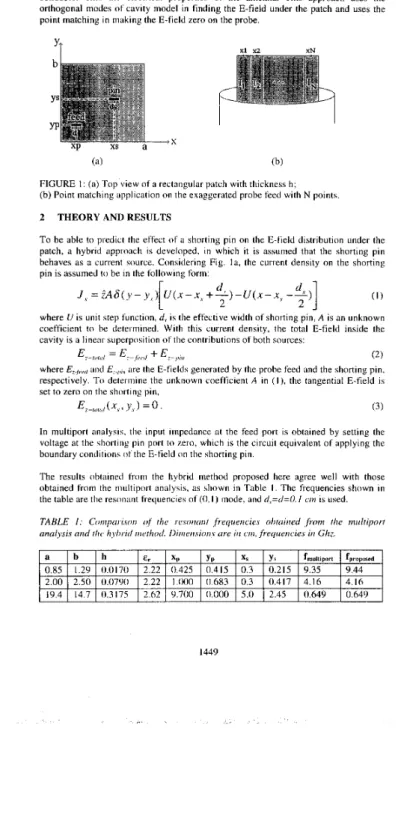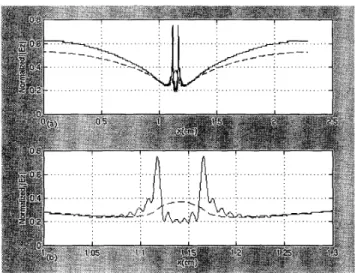HYBRID MODEL FOR PROBE-FED RECTANGULAR MICROSTRIP ANTENNAS WITH SHORTING PINS
S. Mutlu* and M . I. Aksun Bilkent University
Electrical and Electronics Engineering Department Bilkent TR-06533. Ankara, Turkey
Abstract
For a probe-fed microstrip antenna. it is quite common to employ the cavity model to find the field distribution under the patch and other electrical properties Therefore, a multiport analysis technique based on the cavity model is usually employed to predict the input impedance of a probe-fed microstrip iintenna with shorting pins. However, this approach does not provide any information about the field distrihution under the patch with the shorting pins, which is usually used to calculate the radiation properties of the patch antenna. In this study, shorting pins are considered as current sources with unknown amplitudes, and the field distribution under the patch is obtained as a linear superposition of the contributions from each source via cavity model. Then, the unknown current densities over the shorting pins are determined by implementing the boundary condition of the tangential electric field on the pins. This is a hybrid approach becausc the field distribulion is calculated from the cavity model, and the current densities over thc shorting pins arc obtained from the point matching of the resulting field distributions over the shorting conductors. The input impedance results found from this approach agree extremely well with those ohlained from thc multiport analysis. which shows that thc proposed approach predicts hoth the input impedance and the field distribution under the patch. In addition, sincc the (ceding prohe is iilso made of PEC, the electric field under the patch should satisfy the boundary condition on this conductor as well. In the application ofthe cavity model. this is always ignored. with the assumption that the source prohc is too thin to affect the field distribution undcr the patch signilicantly. In this study. the boundary condition of the electric field is implemcnted over the sourcc. 2nd its effect on the lield distribution. in turn on thc resonant frequency, is demonstrated
1 INTRODUCTION
Shorting pins play ail important role in the dual frequency operation of microstrip antennas. By propel-ly placing shorting pins to the microstrip antenna, the ratio of the lowest useful cavity inodes, namely (0,I) and (0.3). can he made less than 3, which is desired in many applications [ I
I.
A hhorting pin placed at the nodal lines of (0.3) mode does not affect the resonant frequency of (0,3) mode, hut increases the resonant frequency of (0.1) mode. Using multiport analysis. the change in the resonant frequency of (0.1) mode due to the shorting pin can be predicted [I], [ 2 ] . However, this analysis does not provide any information about the field distribution inside the cavity. Considering the pins its current sources with unknown current densities, their effects o n the field distribution can he predicted with the use of the cavity model i n conjunction with the point matching technique. In this approach, the application of the point matching is actually the implementation of the boundary conditions over the shorting pins to determine the unknown current densities over these pins.Imposing the boundary condition.; on the shorting pins via point matching can he extended to the feeding probe. which is also made of PEC. In the traditional application of the cavity model, it is always assumed that the feeding probe is quite thin, and does not affect the field distribution under the patch, so no boundary condition is applied except for the discontinuity in the magnetic field by the amount of the known current source. However, in the development of broadband microstrip antennas, recently widei- strips have been used as feeding probes, which significantly alters the resonant frequency and iither electrical properties of the antennas. T h e above mentioned hyhrid method is applied to this problem to assess the effects of the source
conductor onto the electrical properties of the antenna. This approach uses the orthogonal modes o f cavity model in finding the E-field under the patch and uses the point matching in making the E-field zero on the probe.
a b h E ,
0.85 1.29 0.0170 2.22 2.00 2.50 o.0790 2.22 19.4 14.7 (1.3175 2.62
(a) (b)
FIGURE 1: (a) Top view o f a rectangular patch with thickness h; (b) Point matching application on the exaggerated probe feed with N points
2 THEORY AND RESULTS
To be able to predict the effect of a shorting pin on the E-field distribution under the patch, a hybrid approach i s developed, in which i t i s assumed that the shorting pin behaves as a current source. Considering Fig. la, the current density on the shorting pin i s assumed IO be in the following form:
XI' Yp x, Y, fm"ltip"rt fprop<ard
0.42s 0.415 0.3 0.21s 9.3s 9.44
I
(ion
0.683 0.3 0.417 4.16 4.169.700 0.000 5.0 2.45 0.649 0.649
Implementing the boundary condition on the shorting pins with the use of the point matching procedure has brought up the issue of implementing the boundary condition on the feeding probe, wliicli is also a perfect conductor. In the traditional cavity model, the only boundary condition iinpleinented at the source prohe is the discontinuity of the magnetic field by the m o u n t o f the source current. The effect of the probe conductor in tlie cavity is negligible if the thickness of the substrate and the width of the feeding probe al-e very small a h compared to wavelength. However, with the recent advances in tlie dehign of broadband microstrip antennas, thick substrates and wide strips for feeding structures have been quite popular, necessitating their effects to be accounted for. So the hyhrid approach proposed for the starting pins can he easily extended to the feeding structure.
It is observed that the field distribution obtained from the traditional cavity model does not satisfy the houndal-y condition cif the electric field on the feeding conductor, see Fig. 2a, b. T o remedy this, the hybrid method using both cavity model and the point matching methnd is employed. In this approach. the E-field in the cavity is written as a sum of orthognnal iiiodes as in the cavity model, and the tangential E-field is minimized in least square sense on the probe using point matching.
As illustrated i n FIE. I b. the total :directed current on the feed can be written as N
J ,
=CJ,
=I,S(J~-.Y,,)
-, (4)/=I
where d is the effective width of the probe. N
J ,
=CJ,
=I,S(J~-.Y,,)
-, (4)/=I
where d is the ettective width ot the probe T h e total E-field inside the cavity c m be obtained as
where
v,,,,,’s
ai-t: nrthogonnl cavity inodes 121T h e unknown coefficient.; Il’s can he obtained by imposing the boundary condition onto the total electi-ic field on the subsections of the feeding strip, resulting in i i homogeneous imatrix equation with the entries given as
- -
w
,,,,
(x, 3 Y,,)w
,,,,/
( x , ,Y p ) s i n 4 m d / 2 a N )
k 2 - k 2 (6)
,mu ‘ 4 1 =
cc
m=O ,,=I1
Setting the total current to I Amp adds one more row of 1 ’ s to the matrix. T h e least square solution of the inati-ix equation gives I/’s. T h e resonant frequency of the patch is determined by finding the point where the determinant of matrix A is zero.
For a rectangular patch (without shorting pin) with a=I.NI o n , h=1.96 cm, ~,=2.33, h=O.157 cin. vp=O.YOS i v i . yp=O.h27 C I I I . the normalized E-field plots are given in Fig.2. It is ohserved that the magnitude of the E-field drops faster for the hybrid method than that for the cavity inodel on the feed, and at the edges of feed i t increases due to the edge effect. T h e resonant frequency is calculated a s 4.NOI Ghz, which i h
very close to the experimental result off;,.,=4.805 Ghz, given in [31. Note that, in the calculations the effective dimensions ot- the patch are used.
REFERENCES
[ I ]
Y.
T. Lo, C. E. Skupien, and S. S . Zhong, “A study of microstrip antennas for multiple band operation”, Rep. RADC-TR-82-236, Sept. 1982.[ 2 ] W . F. Richards, Y. T. Lo, and D. D. Harrison, “An improved theory for microstrip antennas and applications”, IEEE Trans. Antennas Propagat., vol.AP-29, no I , Jan.
1981.
[3] M. Kara, “The resonant frequency of rectangular microstrip antenna elements with various substrate thicknesses”, Microwave and Optical Tech. Letters, vol. I I , no 2, Feb. 1996.
Figure 2: (a) Normaliied magnitude of E, at y=yp,tf, varying x along side a ; (b) Zoomed view of IE,I around the probe feed.
a=I.Xlon. ~1,.,~=2.28~111, h=l,96rm. bFfl=2.16cm, h=O.I57cm, ~ , = 2 . 3 3 ,
xp=O Y05un. xp,.#= 1. I4cm. yp=0.627cm3 ypp,,=O. 73 cm.
Doshed line: cavity model. solid line: hybrid method

